-
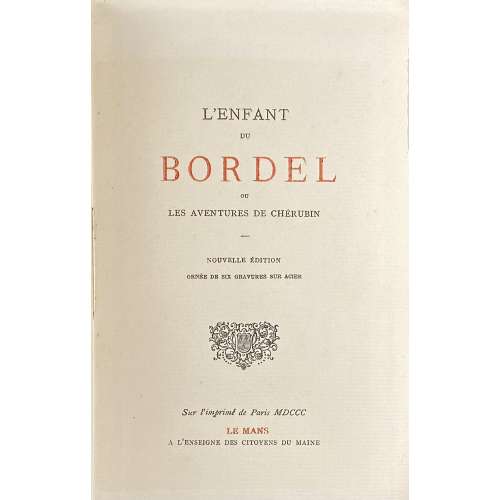 Softcover volume, 17.5 x 11 cm, in-12, brown wrappers without lettering, text printed on laid paper, six plates on India paper barbarously glued in, pp.: fep, [4] (h.t. t.p.), [1-3] 4-182, fep. Title-page (red and black): L’ENFANT | DU | BORDEL | OU | LES AVENTURES DE CHÉRUBIN | – | NOUVELLE ÉDITION | ORNÉE DE SIX GRAVURES SUR ACIER | {fleuron} | Sur l’imprimé de Paris MDCCC | LE MANS | A L’ENSEIGNE DES CITOYENS DU MAINE || Catalogue raisonné: Dutel I: A-325; Pia 395: 222 pages (we have 182 as per Dutel), attributes publication to Poulet-Malassis, 1866. Catalogue Poulet-Malassis & ses amis description: № 82.[PIGAULT-LEBRUN]. L’Enfant du Bordel, ou Les Aventures de Chérubin, nouvelle édition, ornée de six gravures sur acier. Sur l’imprimé de Paris, MDCCC, Le Mans, à l’enseigne des citoyens du Maine. [A. Christiaens, 1875 ?]. In-12, broché. 2 .n.ch., 182 pages, 1 f. blanc, couverture muette en papier vieux orange. Illustré de 6 figures hors-texte sur acier. Bibliographie : G* 553 (40 frs), Dutel A-325. Contributors: Guillaume Charles Antoine Pigault de l'Espinoy [Pigault-Lebrun] (French, 1753 – 1835) – author. Alexis Christiaens (Belgian, d. 1880) – publisher.
Softcover volume, 17.5 x 11 cm, in-12, brown wrappers without lettering, text printed on laid paper, six plates on India paper barbarously glued in, pp.: fep, [4] (h.t. t.p.), [1-3] 4-182, fep. Title-page (red and black): L’ENFANT | DU | BORDEL | OU | LES AVENTURES DE CHÉRUBIN | – | NOUVELLE ÉDITION | ORNÉE DE SIX GRAVURES SUR ACIER | {fleuron} | Sur l’imprimé de Paris MDCCC | LE MANS | A L’ENSEIGNE DES CITOYENS DU MAINE || Catalogue raisonné: Dutel I: A-325; Pia 395: 222 pages (we have 182 as per Dutel), attributes publication to Poulet-Malassis, 1866. Catalogue Poulet-Malassis & ses amis description: № 82.[PIGAULT-LEBRUN]. L’Enfant du Bordel, ou Les Aventures de Chérubin, nouvelle édition, ornée de six gravures sur acier. Sur l’imprimé de Paris, MDCCC, Le Mans, à l’enseigne des citoyens du Maine. [A. Christiaens, 1875 ?]. In-12, broché. 2 .n.ch., 182 pages, 1 f. blanc, couverture muette en papier vieux orange. Illustré de 6 figures hors-texte sur acier. Bibliographie : G* 553 (40 frs), Dutel A-325. Contributors: Guillaume Charles Antoine Pigault de l'Espinoy [Pigault-Lebrun] (French, 1753 – 1835) – author. Alexis Christiaens (Belgian, d. 1880) – publisher. -
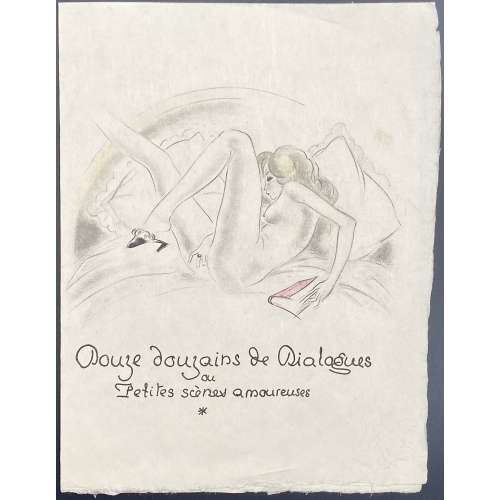 Description: An unbound softcover volume 23 x 18 cm, collated as 17 gatherings in 4to, text in fac-simile manuscript printed on Japon Nacre wove paper with untrimmed outer and bottom margins, with engraved title-page and 11 laid-in hand-coloured etchings after André Collot; in red quarter morocco over marbled boards folder with gilt lettering to spine “P. L. | ~ | PETITES | SCÈNES | AMOUREUSES”, in a matching slipcase 25 x 20 cm. Complete copy with all the pages, incl. the limitation page. Title-page: {vignette in colour} | Douze douzains de Dialogues | ou | Petites scènes amoureuses | * || (text in fac-simile ms). Limitation: Cet ouvrage a été tiré | sure Japn supernacré | à 100 exemplaire | numerotés de I à C | EXEMPLAIRE № LII. Content: (97 dialogues, not 144), similar to Pia: Premier douzain : Dialogues des Filles nues (1, 3, 4, 5, 6) – 5 dialogues; Deuxième douzain : Dialogue[s] des Masturbées (13, 14, 15, 16, 17, 18, 19, 20, [21]) – 9 dialogues; Troisième douzain : Dialogues des Masturbées (25, 26, 27, [28], 29, 30, 31, 32, 33) – 9 dialogues; Quatrième douzain : Dialogues des Lécheuses (37, 38, 39, 40, 41, 42, 44) – 7 dialogues; Cinquième douzain : Dialogues des Phallophores (49, 50, 51, 52, 53, 54) – 6 dialogues; Sixième douzain : Dialogues des Goules (61, 62, 63, 64, 65, 65 (i.e. 66), 67, 68, 69, 70, 71) – 11 dialogues; Septième douzain : Dialogues des Amoureuses (73, 74, 75, 76, 77, 78, 79, [80]) – 8 dialogues; Huitième douzain : Dialogues des Enculées (85, 86, 87, 88, 89, 90, 91, 92, 93, 94, [95]) – 11 dialogues; Neuvième douzain : Dialogues des Chieuses (97, 98, 99, 100, 101, 102, 104) – 7 dialogues; Dixième douzain : Dialogues des Pisseuses (109, 110, 111, 112, 114) – 5 dialogues; Onzième douzain : Dialogues des Mères (121, 122, 123, 124, 125, 126, 127, 128, 129, 130, 131, 132) – 12 dialogues; Douzième douzain : Dialogues des Enfants (134, 135, 136, 137, 138, 139, [140]) – 7 dialogues. Collation: [1]-[17]4; total 68 leaves plus 11 plates. See another copy of the same book in this collection [LIB-2819.2021], where 13 (blank/limitation) is missing. Edition: This copy of "calligraphié" Douze douzains de dialogues ou petites scènes amoureuses was most probably published in Paris by Libraire Robert Télin in 1927, 100 copies on Japon Nacre as per Dutel (1920-1970) № 1427. This is a complete copy with all 68 leaves; LIB-2819.2021 has 67 leaves. Another "calligraphié" edition published in c. 1940 (Dutel 1429) is bound and has 80 leaves. Dutel unequivocally attributes the drawings to André Collot. Plates in this copy are similar to the ones in a pirated copy of Scènes de péripatéticiennes / Douze douzains de dialogues [LIB-2961.2022] (Dutel № 2366). According to Pia (1978) № 358, this is a 1927 edition published in Paris by libraire Robert Télin: « 1 f. blanc, 1 f. (justification), 1 f. (titre) et 65 ff. n. ch., plus 11 gravures à l’eau-forte rehaussées de couleurs ». Edition limited to 100 copies numbered I – C; this copy is № LII (52). Catalogue raisonné: Dutel (1920-1970) №№ 1427 and 1429, p. 137 and № 2366, p. 356 ; Pia (1978) 358-9, p. 199-200. Contributors: Pierre Louÿs (French, 1870 – 1925) – author. André Collot (French, 1897 – 1976) – artist.
Description: An unbound softcover volume 23 x 18 cm, collated as 17 gatherings in 4to, text in fac-simile manuscript printed on Japon Nacre wove paper with untrimmed outer and bottom margins, with engraved title-page and 11 laid-in hand-coloured etchings after André Collot; in red quarter morocco over marbled boards folder with gilt lettering to spine “P. L. | ~ | PETITES | SCÈNES | AMOUREUSES”, in a matching slipcase 25 x 20 cm. Complete copy with all the pages, incl. the limitation page. Title-page: {vignette in colour} | Douze douzains de Dialogues | ou | Petites scènes amoureuses | * || (text in fac-simile ms). Limitation: Cet ouvrage a été tiré | sure Japn supernacré | à 100 exemplaire | numerotés de I à C | EXEMPLAIRE № LII. Content: (97 dialogues, not 144), similar to Pia: Premier douzain : Dialogues des Filles nues (1, 3, 4, 5, 6) – 5 dialogues; Deuxième douzain : Dialogue[s] des Masturbées (13, 14, 15, 16, 17, 18, 19, 20, [21]) – 9 dialogues; Troisième douzain : Dialogues des Masturbées (25, 26, 27, [28], 29, 30, 31, 32, 33) – 9 dialogues; Quatrième douzain : Dialogues des Lécheuses (37, 38, 39, 40, 41, 42, 44) – 7 dialogues; Cinquième douzain : Dialogues des Phallophores (49, 50, 51, 52, 53, 54) – 6 dialogues; Sixième douzain : Dialogues des Goules (61, 62, 63, 64, 65, 65 (i.e. 66), 67, 68, 69, 70, 71) – 11 dialogues; Septième douzain : Dialogues des Amoureuses (73, 74, 75, 76, 77, 78, 79, [80]) – 8 dialogues; Huitième douzain : Dialogues des Enculées (85, 86, 87, 88, 89, 90, 91, 92, 93, 94, [95]) – 11 dialogues; Neuvième douzain : Dialogues des Chieuses (97, 98, 99, 100, 101, 102, 104) – 7 dialogues; Dixième douzain : Dialogues des Pisseuses (109, 110, 111, 112, 114) – 5 dialogues; Onzième douzain : Dialogues des Mères (121, 122, 123, 124, 125, 126, 127, 128, 129, 130, 131, 132) – 12 dialogues; Douzième douzain : Dialogues des Enfants (134, 135, 136, 137, 138, 139, [140]) – 7 dialogues. Collation: [1]-[17]4; total 68 leaves plus 11 plates. See another copy of the same book in this collection [LIB-2819.2021], where 13 (blank/limitation) is missing. Edition: This copy of "calligraphié" Douze douzains de dialogues ou petites scènes amoureuses was most probably published in Paris by Libraire Robert Télin in 1927, 100 copies on Japon Nacre as per Dutel (1920-1970) № 1427. This is a complete copy with all 68 leaves; LIB-2819.2021 has 67 leaves. Another "calligraphié" edition published in c. 1940 (Dutel 1429) is bound and has 80 leaves. Dutel unequivocally attributes the drawings to André Collot. Plates in this copy are similar to the ones in a pirated copy of Scènes de péripatéticiennes / Douze douzains de dialogues [LIB-2961.2022] (Dutel № 2366). According to Pia (1978) № 358, this is a 1927 edition published in Paris by libraire Robert Télin: « 1 f. blanc, 1 f. (justification), 1 f. (titre) et 65 ff. n. ch., plus 11 gravures à l’eau-forte rehaussées de couleurs ». Edition limited to 100 copies numbered I – C; this copy is № LII (52). Catalogue raisonné: Dutel (1920-1970) №№ 1427 and 1429, p. 137 and № 2366, p. 356 ; Pia (1978) 358-9, p. 199-200. Contributors: Pierre Louÿs (French, 1870 – 1925) – author. André Collot (French, 1897 – 1976) – artist. -
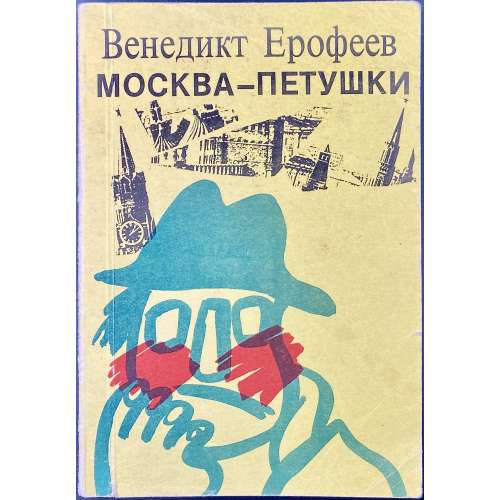 Paperback, 17.2 x 12 cm, yellow pictorial wrappers, lettering to front, back, and spine; pp.: [1-4] 5-137 [5]. Title-page: ВЕНЕДИКТ | ЕРОФЕЕВ | МОСКВА — ПЕТУШКИ | ПОВЕСТЬ | Таллинн | “Александра” | 1990 || Print-run: 30,000. Contributors: Венедикт Васильевич Ерофеев [Venedikt Yerofeyev] (Russian, 1938 – 1990) – author.
Paperback, 17.2 x 12 cm, yellow pictorial wrappers, lettering to front, back, and spine; pp.: [1-4] 5-137 [5]. Title-page: ВЕНЕДИКТ | ЕРОФЕЕВ | МОСКВА — ПЕТУШКИ | ПОВЕСТЬ | Таллинн | “Александра” | 1990 || Print-run: 30,000. Contributors: Венедикт Васильевич Ерофеев [Venedikt Yerofeyev] (Russian, 1938 – 1990) – author. -
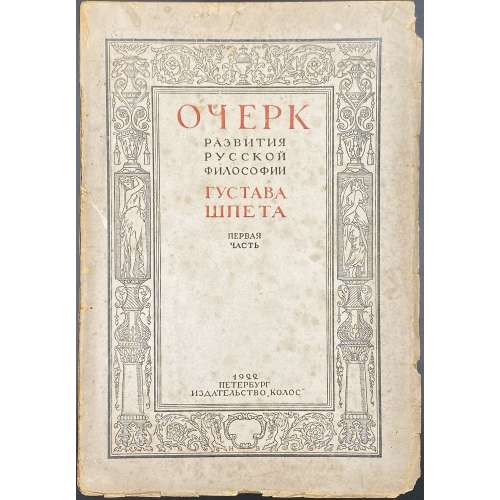 Paperback, 25 x 17 cm, publisher’s wrappers with red and black lettering in a pictorial frame by Vysheslavstev; pp.: [i-vii] viii-xv [xvi blank], [1-5] 6-348 [4]; collated 8vo: π8 1-228, total 184 leaves, 368 pages; gatherings 1-22 uncut. Because the author was banned, lettering on the spine was covered by a glued strip of blank paper; only the year 1922 was left visible. Front wrapper: ОЧЕРК | РАЗВИТИЯ | РУССКОЙ | ФИЛОСОФИИ | ГУСТАВА | ШПЕТА | ПЕРВАЯ | ЧАСТЬ | 1922 | ПЕТЕРБУРГ | ИЗДАТЕЛЬСТВО “КОЛОС” || Title-page: similar lettering in black only with no frame. Design of the front wrapper and the publisher’s device (π1) by Николай Николаевич Вышеславцев [N. Vysheslavstev] (Russian, 1890 – 1952). Title: Sketch on the development of Russian philosophy, Part one. [Part two was never published]. Author: Густав Густавович Шпет [Gustav Shpet] (Russian, 1879 – 1937) – executed by fire squad on 16 November 1937.
Paperback, 25 x 17 cm, publisher’s wrappers with red and black lettering in a pictorial frame by Vysheslavstev; pp.: [i-vii] viii-xv [xvi blank], [1-5] 6-348 [4]; collated 8vo: π8 1-228, total 184 leaves, 368 pages; gatherings 1-22 uncut. Because the author was banned, lettering on the spine was covered by a glued strip of blank paper; only the year 1922 was left visible. Front wrapper: ОЧЕРК | РАЗВИТИЯ | РУССКОЙ | ФИЛОСОФИИ | ГУСТАВА | ШПЕТА | ПЕРВАЯ | ЧАСТЬ | 1922 | ПЕТЕРБУРГ | ИЗДАТЕЛЬСТВО “КОЛОС” || Title-page: similar lettering in black only with no frame. Design of the front wrapper and the publisher’s device (π1) by Николай Николаевич Вышеславцев [N. Vysheslavstev] (Russian, 1890 – 1952). Title: Sketch on the development of Russian philosophy, Part one. [Part two was never published]. Author: Густав Густавович Шпет [Gustav Shpet] (Russian, 1879 – 1937) – executed by fire squad on 16 November 1937. -
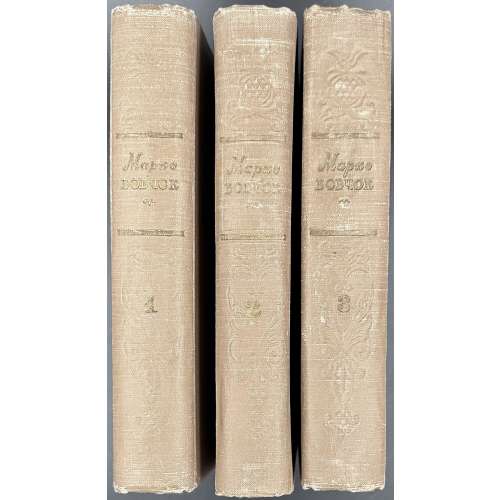 Three 8vo volumes, 20.8 x 13.8 cm each, uniformly bound in brown cloth with gilt lettering and embossed design to front and spine; v. 1: [1-4] 5-537 [3], total 540 pages plus frontispiece, two-colour woodcut portrait, by Ivan Nikolaevtsev; v. 2: [1-6] 7-537 [3], total 540 pages; v. 3: [1-6] 7-620 [4], total 624 pages. Waterstain throughout the third volume. Title-page (red and black): Марко Вовчок | СОБРАНИЕ СОЧИНЕНИЙ | ТОМ ПЕРВЫЙ (ВТОРОЙ, ТРЕТИЙ) | {fleuron} | ИЗДАТЕЛЬСТВО «ИЗВЕСТИЯ» | Москва | 1957 || Opposite t.p. (red and black): Марко Вовчок | СОБРАНИЕ СОЧИНЕНИЙ | В ТРЕХ | ТОМАХ | {fleuron} | ИЗДАТЕЛЬСТВО «ИЗВЕСТИЯ» | Москва | 1957 || Half-title (red and black): БИБЛИОТЕКА КЛАССИКОВ | ЛИТЕРАТУР | НАРОДОВ СССР | | {fleuron} || Imprint: Вступительная статья А. Белецкого. Подготовка текста и примечания С. Машинского. Print run: 30,000 copies. Contributors: Марко Вовчок [Marko Vovchok; Марія Олександрівна Вілінська] (Ukrainian, 1833 – 1907) – author. Other variants: Markowovzok and Marko Vovtchok. Олександр Іванович Білецький [Александр Иванович Белецкий] (Ukrainian, 1884 – 1961) – author/preface. Семен Иосифович Машинский (Ukrainian, 1914-1978) – author/editing and comments. Иван Григорьевич Николаевцев (Ukrainian, 1902–1960) – artist.
Three 8vo volumes, 20.8 x 13.8 cm each, uniformly bound in brown cloth with gilt lettering and embossed design to front and spine; v. 1: [1-4] 5-537 [3], total 540 pages plus frontispiece, two-colour woodcut portrait, by Ivan Nikolaevtsev; v. 2: [1-6] 7-537 [3], total 540 pages; v. 3: [1-6] 7-620 [4], total 624 pages. Waterstain throughout the third volume. Title-page (red and black): Марко Вовчок | СОБРАНИЕ СОЧИНЕНИЙ | ТОМ ПЕРВЫЙ (ВТОРОЙ, ТРЕТИЙ) | {fleuron} | ИЗДАТЕЛЬСТВО «ИЗВЕСТИЯ» | Москва | 1957 || Opposite t.p. (red and black): Марко Вовчок | СОБРАНИЕ СОЧИНЕНИЙ | В ТРЕХ | ТОМАХ | {fleuron} | ИЗДАТЕЛЬСТВО «ИЗВЕСТИЯ» | Москва | 1957 || Half-title (red and black): БИБЛИОТЕКА КЛАССИКОВ | ЛИТЕРАТУР | НАРОДОВ СССР | | {fleuron} || Imprint: Вступительная статья А. Белецкого. Подготовка текста и примечания С. Машинского. Print run: 30,000 copies. Contributors: Марко Вовчок [Marko Vovchok; Марія Олександрівна Вілінська] (Ukrainian, 1833 – 1907) – author. Other variants: Markowovzok and Marko Vovtchok. Олександр Іванович Білецький [Александр Иванович Белецкий] (Ukrainian, 1884 – 1961) – author/preface. Семен Иосифович Машинский (Ukrainian, 1914-1978) – author/editing and comments. Иван Григорьевич Николаевцев (Ukrainian, 1902–1960) – artist. -
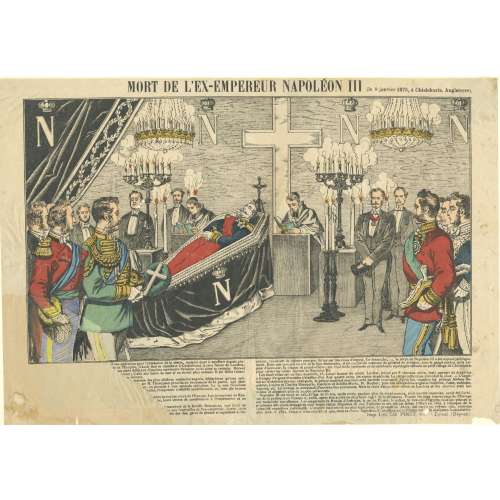 Hand-coloured woodcut on wove paper, 270 x 380 mm; attached to the sheet 303 x 442 mm with pencil ms inscription to the top left corner on the reverse: “Haye le 2-3-75”. Top: "MORT DE L'EX-EMPEREUR NAPOLÉON III (le 9 janvier 1873, à Chislehurts [sic], Angleterre)." Bottom right: "Imp. Lith. CH. PINOT, éditeur. Épinal (Dépose)". Bottom left corner of the image sheet torn and manually restored. Text partially lost, starting with « d’une opération pour l’extraction de la pierre, maladie dont’ il souffrait depuis plu-… ». See Chislehurst. Charles-François Pinot (French, 1817 – 1879) – publisher/printer.
Hand-coloured woodcut on wove paper, 270 x 380 mm; attached to the sheet 303 x 442 mm with pencil ms inscription to the top left corner on the reverse: “Haye le 2-3-75”. Top: "MORT DE L'EX-EMPEREUR NAPOLÉON III (le 9 janvier 1873, à Chislehurts [sic], Angleterre)." Bottom right: "Imp. Lith. CH. PINOT, éditeur. Épinal (Dépose)". Bottom left corner of the image sheet torn and manually restored. Text partially lost, starting with « d’une opération pour l’extraction de la pierre, maladie dont’ il souffrait depuis plu-… ». See Chislehurst. Charles-François Pinot (French, 1817 – 1879) – publisher/printer. -
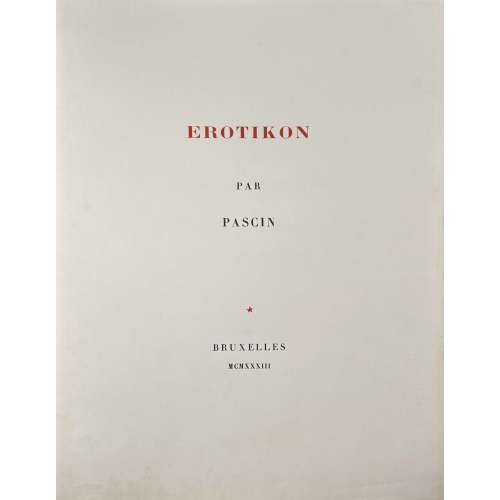 A portfolio of nine heliogravures after Jules Pascin. Cloth-backed cardboard portfolio 420 x 335 mm with 9 heliogravures on slightly tinted india paper, each numbered in pencil and mounted into a passe-partout 410 x 318 mm. Copy № 25 out of 40 printed on india (chine) paper. Copy № 25 of 40. Title (red and black): EROTIKON | PAR | PASCIN | ★ | BRUXELLES | MCMXXXIII || Limitation: CET | ALBUM | A ÉTÉ TIRÉ | A | QUARANTE ET UN EXEMPLAIRES | NUMÉROTÉS | DONT | UN EX. SUR PAPIER ANCIEN | & | QUARANTE EX. SUR CHINE | No (ms 25/40) || Catalogue raisonné: Dutel III № 1498. Seller's description:Neun Heliogravüren. 1933. Meist ca. 30 : 35 cm. Nummeriert. Exemplar 25/40 (Gesamtauflage 41). – Die Heliogravüren auf leicht getöntem China, jedes Blatt mit Bleistift nummeriert und in Passepartouts montiert. – Die neun Passepartouts eingelegt in zwei Büttenumschläge, einer mit Titel und dem nummerierten Auflagenvermerk, der zweite unbedruckt, ferner Büttenumschlag mit Titel in Rotdruck und Halbleinenchemise. – Die Heliogravüren erschienen 1933, drei Jahre nach Pascins Tod bei Daragnes in Paris mit der fingierten Angabe »Brüssel«. – Das berühmte Mappenwerk bildet eine der großen Seltenheiten der erotischen Kunst. Die Motive Pascins beschreibt das Bilderlexikon als »eine Art ›Boheme-Rokoko im Montmartre-Milieu‹« und lobt den Künstler: »Er ist ein außerordentlicher Zeichner, der es versteht, bei allem Zynismus, der seinen exhibitionistischen Charakter nicht verleugnet, auf diesem Kulturdünger eine neuartige Blume voll graziöser Schönheit erblühen zu lassen.« Mappe: 42 : 33,5 cm. – Der äußere Büttenumschlag mit leichtem Wasserrand. – Zwei Heliogravüren minimal stockfleckig, sonst tadellos und absolut vollständig. Dutel 1498 (mit Auflagenvarianten). – Der kalte Blick S. 198ff. – Bilderlexikon II, 718.
A portfolio of nine heliogravures after Jules Pascin. Cloth-backed cardboard portfolio 420 x 335 mm with 9 heliogravures on slightly tinted india paper, each numbered in pencil and mounted into a passe-partout 410 x 318 mm. Copy № 25 out of 40 printed on india (chine) paper. Copy № 25 of 40. Title (red and black): EROTIKON | PAR | PASCIN | ★ | BRUXELLES | MCMXXXIII || Limitation: CET | ALBUM | A ÉTÉ TIRÉ | A | QUARANTE ET UN EXEMPLAIRES | NUMÉROTÉS | DONT | UN EX. SUR PAPIER ANCIEN | & | QUARANTE EX. SUR CHINE | No (ms 25/40) || Catalogue raisonné: Dutel III № 1498. Seller's description:Neun Heliogravüren. 1933. Meist ca. 30 : 35 cm. Nummeriert. Exemplar 25/40 (Gesamtauflage 41). – Die Heliogravüren auf leicht getöntem China, jedes Blatt mit Bleistift nummeriert und in Passepartouts montiert. – Die neun Passepartouts eingelegt in zwei Büttenumschläge, einer mit Titel und dem nummerierten Auflagenvermerk, der zweite unbedruckt, ferner Büttenumschlag mit Titel in Rotdruck und Halbleinenchemise. – Die Heliogravüren erschienen 1933, drei Jahre nach Pascins Tod bei Daragnes in Paris mit der fingierten Angabe »Brüssel«. – Das berühmte Mappenwerk bildet eine der großen Seltenheiten der erotischen Kunst. Die Motive Pascins beschreibt das Bilderlexikon als »eine Art ›Boheme-Rokoko im Montmartre-Milieu‹« und lobt den Künstler: »Er ist ein außerordentlicher Zeichner, der es versteht, bei allem Zynismus, der seinen exhibitionistischen Charakter nicht verleugnet, auf diesem Kulturdünger eine neuartige Blume voll graziöser Schönheit erblühen zu lassen.« Mappe: 42 : 33,5 cm. – Der äußere Büttenumschlag mit leichtem Wasserrand. – Zwei Heliogravüren minimal stockfleckig, sonst tadellos und absolut vollständig. Dutel 1498 (mit Auflagenvarianten). – Der kalte Blick S. 198ff. – Bilderlexikon II, 718. -
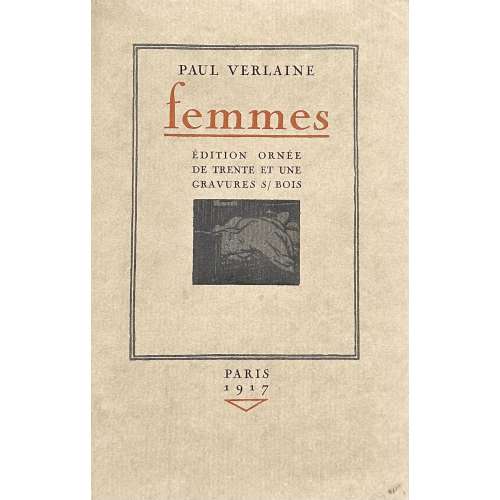 Softcover, 258 x 166 mm, publisher’s olive French flapped wrappers in owner’s glassine dustcover, edges untrimmed, some pages uncut, printed on thick wove paper with watermark “Hollande van Gelder Zonen”, in a slipcase. Pp.: [1-10] 11-129 [5], pages in wrappers included in the count, total 67 leaves; two-tone woodcuts by Jean-Gabriel Daragnès within the pagination. Title-page (red and black, in a double-fillet frame): PAUL VERLAINE | femmes | ÉDITION ORNÉE | DE TRENTE ET UNE | GRAVURES S/ BOIS | {vignette} | (under the bottom frame) PARIS | 1917 | {red triangle} || Limitation: Il a été tiré de cet ouvrage : 11 15 Exemplaires sur vieux papier de Japon numérotés de I à XV; 15 20 Exemplaires sur papier de Chine numérotés de XVI à XXXV; auxquels on a joint une suite des fumés sur même papier. 250 Exemplaires sur papier vélin de Hollande Van Gelder Zonen numérotés de 1 à 250. Après le tirage les bois ont été détruits. № 1. Numbers “15” and “20” corrected manually by Daragnès (per Dutel). This is copy № of vélin de Hollande print run. Catalogue raisonné: Dutel II: № 295; Nordmann II № 544. Seller’s description: Un volume broché in-8° sous couverture illustrée et rempliée. Etui cartonné. Illustré de 31 gravures sur bois en camaïeu, attribuées à DARAGNES, la plupart très libres, dont 18 à pleine page. Tiré à [226 ou 285] ex. numérotés. 1 des [200 ou 250] sur Hollande Van Gelder Zonen. Le nôtre porte le n°1. (Dutel : 295. Pia : 501. Carteret : IV, 392 : Belle édition rare, très estimée ». Monod : 11086). Dorgelès commenta ainsi ces illustrations : « Dans ces nus voluptueux et tragiques, qui semblent à la fois s’aimer et se haïr, on retrouve la même frénésie amère qui tourmente les poèmes interdits de Verlaine » (in Catalogue de livres... Daragnès, Drouot 1924, n°55). Très rares rousseurs. TRES BON EXEMPLAIRE, toujours recherché. Contributors: Paul Verlaine (French, 1844 – 1896) – author. Jean-Gabriel Daragnès (French, 1886 – 1950) – artist/publisher.
Softcover, 258 x 166 mm, publisher’s olive French flapped wrappers in owner’s glassine dustcover, edges untrimmed, some pages uncut, printed on thick wove paper with watermark “Hollande van Gelder Zonen”, in a slipcase. Pp.: [1-10] 11-129 [5], pages in wrappers included in the count, total 67 leaves; two-tone woodcuts by Jean-Gabriel Daragnès within the pagination. Title-page (red and black, in a double-fillet frame): PAUL VERLAINE | femmes | ÉDITION ORNÉE | DE TRENTE ET UNE | GRAVURES S/ BOIS | {vignette} | (under the bottom frame) PARIS | 1917 | {red triangle} || Limitation: Il a été tiré de cet ouvrage : 11 15 Exemplaires sur vieux papier de Japon numérotés de I à XV; 15 20 Exemplaires sur papier de Chine numérotés de XVI à XXXV; auxquels on a joint une suite des fumés sur même papier. 250 Exemplaires sur papier vélin de Hollande Van Gelder Zonen numérotés de 1 à 250. Après le tirage les bois ont été détruits. № 1. Numbers “15” and “20” corrected manually by Daragnès (per Dutel). This is copy № of vélin de Hollande print run. Catalogue raisonné: Dutel II: № 295; Nordmann II № 544. Seller’s description: Un volume broché in-8° sous couverture illustrée et rempliée. Etui cartonné. Illustré de 31 gravures sur bois en camaïeu, attribuées à DARAGNES, la plupart très libres, dont 18 à pleine page. Tiré à [226 ou 285] ex. numérotés. 1 des [200 ou 250] sur Hollande Van Gelder Zonen. Le nôtre porte le n°1. (Dutel : 295. Pia : 501. Carteret : IV, 392 : Belle édition rare, très estimée ». Monod : 11086). Dorgelès commenta ainsi ces illustrations : « Dans ces nus voluptueux et tragiques, qui semblent à la fois s’aimer et se haïr, on retrouve la même frénésie amère qui tourmente les poèmes interdits de Verlaine » (in Catalogue de livres... Daragnès, Drouot 1924, n°55). Très rares rousseurs. TRES BON EXEMPLAIRE, toujours recherché. Contributors: Paul Verlaine (French, 1844 – 1896) – author. Jean-Gabriel Daragnès (French, 1886 – 1950) – artist/publisher. -

Б. Л. Модзалевский. Библиотека А.С.Пушкина. Библиографическое описание. Отдѣльный оттискъ из изданiя "Пушкинъ и его современники", вып. IX-X. -- СПб.: Тип. Императорской Академiи Наук, 1910. - 442 стр. [РЕПРИНТ 1988 года.]
Библиотека А. С. Пушкина. Б. Л. Модзалевский. Приложение к репринтному изданию. -- М.: Книга, 1988. - 115 стр. Тираж 10 000 экз.
Л. Б. Модзалевский. Библиотека Пушкина. Новые материалы.
Список условных сокращений.
Л. С. Сидяков. Библиотека Пушкина и ее описание.
Примечание к работам Б. Л. и Л. Б. Модзалевских.
-
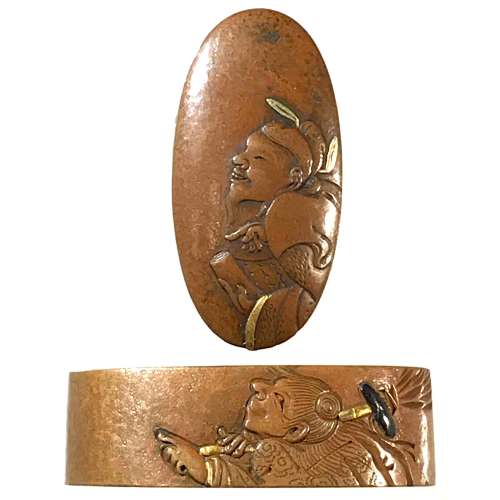 Fuchi-kashira of copper, carved and inlaid with gold and shakudō, with the design of Kanzan (on kashira), Chinese: Hanshan, an eccentric poet of the Tang dynasty with a scroll (618-906) who befriended Jittoku (on fuchi, Chinese: Shide, a kitchen helper at a mountain temple, holding a broom). Fuchi is signed Josui (如⽔). Fuchi (Jittoku, holding a broom): 38 x 22 x 12 mm. Weight: 23g (Nakago hole: 27 x 8.5 mm); Kashira (Kanzan, reading a scroll): 34 x 17 x 9 mm. Weight: 10g. Materials: Copper, gold, shakudō. Techniques: Tsuchi-me-ji (hammer-marked surface); usu-shishiai-bori or usuniku-bori (low-relief carving which leaves the image somewhat higher than the surface - high relief effect); zōgan (inlay). Josui was a daughter of Jochiku Kamo (Markus Sesko, Genealogies).
Fuchi-kashira of copper, carved and inlaid with gold and shakudō, with the design of Kanzan (on kashira), Chinese: Hanshan, an eccentric poet of the Tang dynasty with a scroll (618-906) who befriended Jittoku (on fuchi, Chinese: Shide, a kitchen helper at a mountain temple, holding a broom). Fuchi is signed Josui (如⽔). Fuchi (Jittoku, holding a broom): 38 x 22 x 12 mm. Weight: 23g (Nakago hole: 27 x 8.5 mm); Kashira (Kanzan, reading a scroll): 34 x 17 x 9 mm. Weight: 10g. Materials: Copper, gold, shakudō. Techniques: Tsuchi-me-ji (hammer-marked surface); usu-shishiai-bori or usuniku-bori (low-relief carving which leaves the image somewhat higher than the surface - high relief effect); zōgan (inlay). Josui was a daughter of Jochiku Kamo (Markus Sesko, Genealogies). -
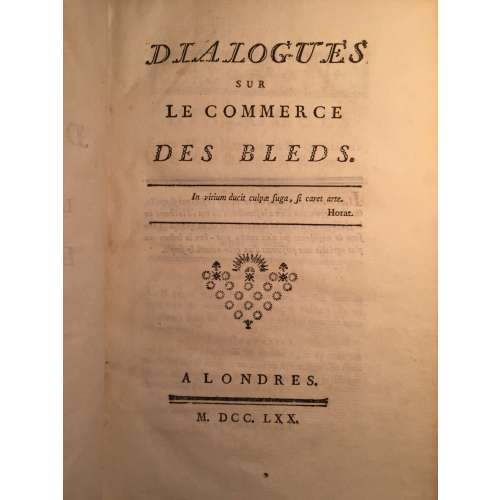
GALIANI, Ferdinando, Abbé. Dialogue sur le commerce des bleds. Londres, 1770. L'Abbé Roubaud, Pierre Joseph André. Récréations économiques ou lettres de l'auteur des représentations aux magistrats, a M. le chevalier Zanobi, principal interlocuteur des Dialogues sur le commerce des bleds; Amsterdam & Paris, Delalain, 1770. Béguillet, Edme. De principiis vegetationis et agreculturae et de causis triplicis culturae in Burgundia disquisitio physica. Auctore E.B.D. ex Societate Œconomica Lugdunensi; Divione, 1768.
-
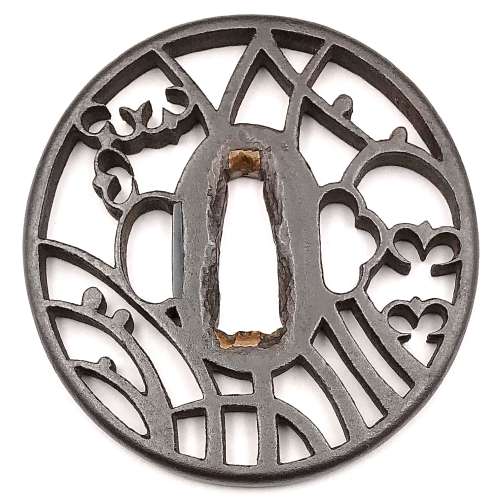 Iron tsuba of slightly elongated round form with design of wild geese and drops on pampas grass (masashino) in openwork (sukashi). Rounded rim. Copper sekigane. Owari school. Early Edo period: early 17th century (Kan-ei era). Height: 78.8 mm. Width: 76.3 mm. Rim thickness: 6.1 mm. Center thickness: 6.4 mm. Provenance: Sasano Masayuki Collection, № 169. A description of musashino symbolism can be found at Symbols of Japan by Merrily Baird [Merrily Baird. Symbols of Japan. Thematic motifs in art and design. Rizzoli international publications, Inc., 2001]: Musashino - "the plain of Musashi - a large expanse in the Tokyo area, was celebrated in poetry for the grasses that grew there before the recent era of industrialization... The use of Musashino themes was particularly common in the Momoyama and Edo periods". Pampas grass with dew drops and wild geese in flight collectively provide strong autumnal connotation.
Iron tsuba of slightly elongated round form with design of wild geese and drops on pampas grass (masashino) in openwork (sukashi). Rounded rim. Copper sekigane. Owari school. Early Edo period: early 17th century (Kan-ei era). Height: 78.8 mm. Width: 76.3 mm. Rim thickness: 6.1 mm. Center thickness: 6.4 mm. Provenance: Sasano Masayuki Collection, № 169. A description of musashino symbolism can be found at Symbols of Japan by Merrily Baird [Merrily Baird. Symbols of Japan. Thematic motifs in art and design. Rizzoli international publications, Inc., 2001]: Musashino - "the plain of Musashi - a large expanse in the Tokyo area, was celebrated in poetry for the grasses that grew there before the recent era of industrialization... The use of Musashino themes was particularly common in the Momoyama and Edo periods". Pampas grass with dew drops and wild geese in flight collectively provide strong autumnal connotation. -
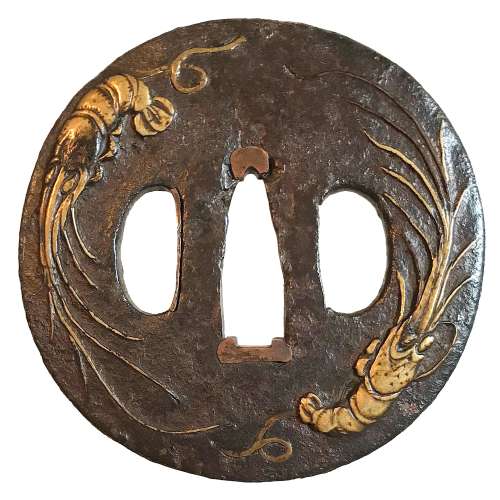 Iron tsuba of round form with two ebi (lobster) on omote (obverse side) and shika (deer) among scattered momiji (maple leaves) on ura (reverse side) motif in brass takabori (high relief) suemon-zōgan. Traces of lacquer. Unsigned. Late Muromachi / Momoyama period (late 16th / Early 17th century). Dimensions: 69.0.6 mm (H) x 69.6 mm (W) x 3.4 mm (T, seppa-dai). Weight: 92.6 g. Illustrated at: The Lundgren Collection of Japanese Swords, Sword Fittings and A Group of Miochin School Metalwork. Christie's Auction: Tuesday, 18 November 1997, London. Sales "GOTO-5881". Christie's, 1997. - #2 at page 7. Provenance: The second John Harding; The Lundgren Collection. Description at Christie's: "The iron plate depicting two lobsters in takabory and brass takazogan, the reverse similarly decorated with deer among scattered maple leaves, square mimi, late Muromachi / early Momoyama period (late 16th/early 17th century) Diameter 68 mm, mimi thickness 4 mm. Provenance: The second John Harding." Also at: JAPANESE SWORD-FITTINGS & METALWORK IN THE LUNDGREN COLLECTION. Published by Otsuka Kogeisha, Tokyo 1992. № 134. Description on page 173: Sword guard with design of shrimps in inlay (scarlet [sic] maple leaves and deer on the reverse side). Unsigned. Heianjō inlay school. Vertical 6.85 cm, horizontal 6.90 cm, Th. of rim 0.40 cm. Iron. Taka-bori relief and brass inlay. Momoyama period, 16th - 17th century. According to Merrily Baird, maple leaves, especially if paired with the deer, allude to autumnal tradition of Japanese aristocracy of viewing the seasonal changes of color in the Nara area. The lobster is typical Japanese ebi, - it lacks prominent claws, and has a spiny shell. As a symbol of longevity and good fortune, lobster is a staple of New Year's decoration.
Iron tsuba of round form with two ebi (lobster) on omote (obverse side) and shika (deer) among scattered momiji (maple leaves) on ura (reverse side) motif in brass takabori (high relief) suemon-zōgan. Traces of lacquer. Unsigned. Late Muromachi / Momoyama period (late 16th / Early 17th century). Dimensions: 69.0.6 mm (H) x 69.6 mm (W) x 3.4 mm (T, seppa-dai). Weight: 92.6 g. Illustrated at: The Lundgren Collection of Japanese Swords, Sword Fittings and A Group of Miochin School Metalwork. Christie's Auction: Tuesday, 18 November 1997, London. Sales "GOTO-5881". Christie's, 1997. - #2 at page 7. Provenance: The second John Harding; The Lundgren Collection. Description at Christie's: "The iron plate depicting two lobsters in takabory and brass takazogan, the reverse similarly decorated with deer among scattered maple leaves, square mimi, late Muromachi / early Momoyama period (late 16th/early 17th century) Diameter 68 mm, mimi thickness 4 mm. Provenance: The second John Harding." Also at: JAPANESE SWORD-FITTINGS & METALWORK IN THE LUNDGREN COLLECTION. Published by Otsuka Kogeisha, Tokyo 1992. № 134. Description on page 173: Sword guard with design of shrimps in inlay (scarlet [sic] maple leaves and deer on the reverse side). Unsigned. Heianjō inlay school. Vertical 6.85 cm, horizontal 6.90 cm, Th. of rim 0.40 cm. Iron. Taka-bori relief and brass inlay. Momoyama period, 16th - 17th century. According to Merrily Baird, maple leaves, especially if paired with the deer, allude to autumnal tradition of Japanese aristocracy of viewing the seasonal changes of color in the Nara area. The lobster is typical Japanese ebi, - it lacks prominent claws, and has a spiny shell. As a symbol of longevity and good fortune, lobster is a staple of New Year's decoration. -
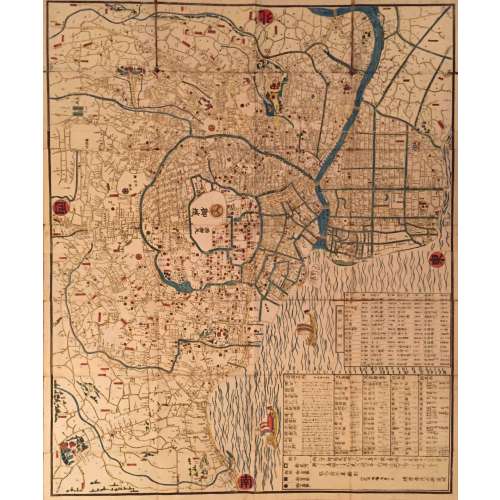
-
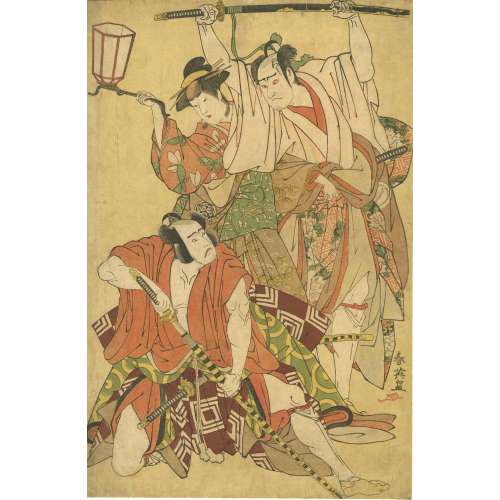 Katsukawa Shun'ei. Signed: Shun'ei ga (春英画). Vertical Ōban. No reference whatsoever. Unidentified play, actors, roles, year, theatre. SOLD
Katsukawa Shun'ei. Signed: Shun'ei ga (春英画). Vertical Ōban. No reference whatsoever. Unidentified play, actors, roles, year, theatre. SOLD -
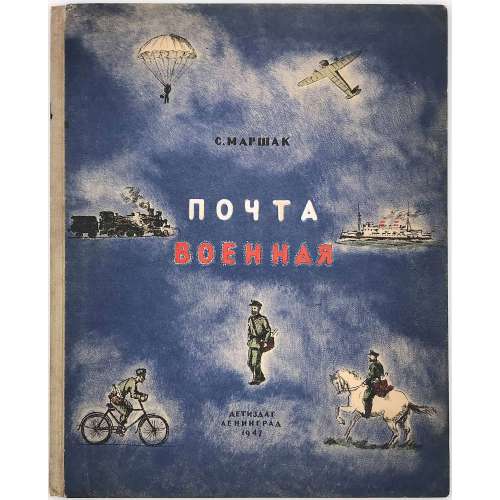 С. Маршак. Почта военная. Детиздат : Ленинград, 1947.
С. Маршак. Почта военная. Детиздат : Ленинград, 1947.Hard-bound Quatro (304 x 246 mm) printed in lithography with hand-colored details on cover.
The name of artist hardly legible on a stamp on frontispiece: скворцов.
The text repeats itself on multiple pages. Most probably the book is a pilot run, never went to mass printing and distribution. -
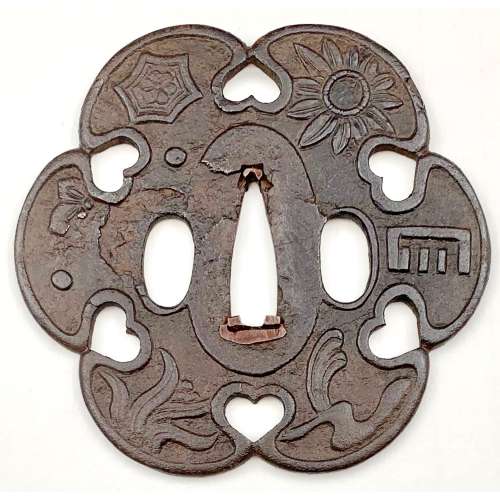 Iron tsuba of six-lobed (mutsu-mokkō-gata) form, with six wild boar's eye shape (inome) openings (sukashi). Ryo-Hitsu and the entire perimeter of tsuba have typical for this school raised rim; raised seppa dai. Lobes are decorated in low relief carving (sukidashi-bori). On the obverse: chrysanthemum, Genji mon, waves and rocks, grasses and star, bellflower, star and flower in tortoiseshell (kikko). On the reverse: Stars and different flowers, and flying geese. The plate is damaged to the left of nakago-ana and around the left hitsu-ana. Kamakura-bori school. Late Muromachi period (1514-1573). Diameter: 89 mm; Thickness at seppa-dai: 4.0 mm; Weight: 108.8 g [large]. There is a similar tsuba in this collection, TSU-0345.2018, but with a different motif and much smaller: diameter 74.3 mm, thickness at seppa-dai: 3.2 mm, weight: 62.8 g.Another look-a-like tsuba can be found at the Compton Collection, part II, pp. 14-15, №17, though his tsuba is more massive (80 x 84 x 4 mm).
Iron tsuba of six-lobed (mutsu-mokkō-gata) form, with six wild boar's eye shape (inome) openings (sukashi). Ryo-Hitsu and the entire perimeter of tsuba have typical for this school raised rim; raised seppa dai. Lobes are decorated in low relief carving (sukidashi-bori). On the obverse: chrysanthemum, Genji mon, waves and rocks, grasses and star, bellflower, star and flower in tortoiseshell (kikko). On the reverse: Stars and different flowers, and flying geese. The plate is damaged to the left of nakago-ana and around the left hitsu-ana. Kamakura-bori school. Late Muromachi period (1514-1573). Diameter: 89 mm; Thickness at seppa-dai: 4.0 mm; Weight: 108.8 g [large]. There is a similar tsuba in this collection, TSU-0345.2018, but with a different motif and much smaller: diameter 74.3 mm, thickness at seppa-dai: 3.2 mm, weight: 62.8 g.Another look-a-like tsuba can be found at the Compton Collection, part II, pp. 14-15, №17, though his tsuba is more massive (80 x 84 x 4 mm).
Varshavsky Collection: TSU-0345.2018
This tsuba, TSU-0401.2019, is the biggest of all three (another mine and the one from Campton Collection). The presence of a flower in a tortoiseshell symbol (crest or mon) on this tsuba alludes to Izumo Shrine. The overall piece, with symbols of grasses, waves, flowers, incense, stars, and flying geese, is full of autumnal connotations.
Compton Collection, part II, pp. 14-15, №17: Kamakura-bori tsuba, ca. 1450.
-
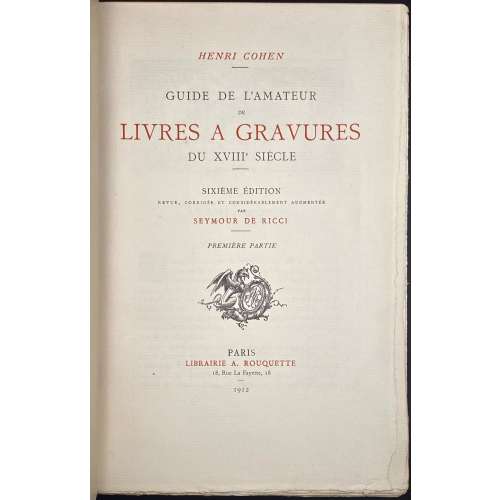 Herni Cohen. Guide de l'amateur de livres à gravures du XVIIIe siècle (6e édition) / Revue, corrigée et considérablement augmentée par Seymour de Ricci, préface par R. Portalis; 2 Volumes. – Paris: Librairie A. Rouquette, 1912. – Achevé d'Imprimer à Melun par Émile Legrand le 25 juin MDCCCCXII [1912]. Vol. 1, Première partie – ABAA-LUY: ffl [4 blanks] [2 - orig. grey front wrapper w/title, verso blank] [2 blanks] [2 - ht, tirage] [2 - blank, frontis. w/protect. sheet] [2 - blank, frontis. w/protect. sheet] (double frontis. - correct), [2 - t.p., blank] [i - avant-propos w/vignette] ii-vi, [vii - préface w/vignette] viii-xxvi; [1-2 - Tome 1, I] 2-668 (two numbers per page), [2 - fin, blank] [2 blanks] [2 - orig. grey back wrapper, recto blank] [orig. spine strip] [4 blanks] bfl. Vol. 2, Seconde partie – MAB-ZUR : ffl [4 blanks] [2 - orig. grey front wrapper w/title, verso blank] [2 blanks] [2 - ht, blank] [2 - t.p., blank] [2 - blank, frontis. w/protect. sheet] [2 - blank, frontis. w/protect. sheet] (double frontis. - correct), [1-2 - Tome II, 22] 671-1248 (two numbers per page), [2 - printer, blank] [2 blanks] [2 - orig. grey back wrapper, recto imprim.] [orig. spine strip] [4 blanks] bfl. Size: Super Royal 8vo, 26.2 x 17.2 x 5.1 cm. Binding: Contemporary blue half morocco over marbled boards, marbled end-papers, top margin gilt, gilt lettering to spine (title, owner: P. R.).; bookplate pasted to verso of the first blank leaf: " Ex Libris R. Decamps Scrive." – for bibliophile René Descamps-Scrive (French, 1853 –1924). Original wrappers preserved. Printed on Hollande paper, copy № 2 of the first 50; total print-run 1050 copies. Catalogue raisonné of French illustrated books of the 18th century.
Herni Cohen. Guide de l'amateur de livres à gravures du XVIIIe siècle (6e édition) / Revue, corrigée et considérablement augmentée par Seymour de Ricci, préface par R. Portalis; 2 Volumes. – Paris: Librairie A. Rouquette, 1912. – Achevé d'Imprimer à Melun par Émile Legrand le 25 juin MDCCCCXII [1912]. Vol. 1, Première partie – ABAA-LUY: ffl [4 blanks] [2 - orig. grey front wrapper w/title, verso blank] [2 blanks] [2 - ht, tirage] [2 - blank, frontis. w/protect. sheet] [2 - blank, frontis. w/protect. sheet] (double frontis. - correct), [2 - t.p., blank] [i - avant-propos w/vignette] ii-vi, [vii - préface w/vignette] viii-xxvi; [1-2 - Tome 1, I] 2-668 (two numbers per page), [2 - fin, blank] [2 blanks] [2 - orig. grey back wrapper, recto blank] [orig. spine strip] [4 blanks] bfl. Vol. 2, Seconde partie – MAB-ZUR : ffl [4 blanks] [2 - orig. grey front wrapper w/title, verso blank] [2 blanks] [2 - ht, blank] [2 - t.p., blank] [2 - blank, frontis. w/protect. sheet] [2 - blank, frontis. w/protect. sheet] (double frontis. - correct), [1-2 - Tome II, 22] 671-1248 (two numbers per page), [2 - printer, blank] [2 blanks] [2 - orig. grey back wrapper, recto imprim.] [orig. spine strip] [4 blanks] bfl. Size: Super Royal 8vo, 26.2 x 17.2 x 5.1 cm. Binding: Contemporary blue half morocco over marbled boards, marbled end-papers, top margin gilt, gilt lettering to spine (title, owner: P. R.).; bookplate pasted to verso of the first blank leaf: " Ex Libris R. Decamps Scrive." – for bibliophile René Descamps-Scrive (French, 1853 –1924). Original wrappers preserved. Printed on Hollande paper, copy № 2 of the first 50; total print-run 1050 copies. Catalogue raisonné of French illustrated books of the 18th century.


